E-commerce is increasingly claiming a bigger chunk of global retail sales, with 20.8% of retail purchases expected to happen online in 2023. But the rapid expansion of the landscape is driving a rapid evolution, and businesses must be agile and efficient to stay competitive.
For a long time, businesses have only relied on enterprise resource planning (ERP) software for efficient operations, but this is no longer tenable. Instead, companies have discovered that combining ERP technology with product information management (PIM) platforms is the new solution for agility and efficiency.
But what is PIM ERP integration? How do businesses synchronize the tools for efficient and effective operations? In this light, this article explores how integrating ERP and PIM software can propel your e-commerce strategy.

The Fundamentals of ERP System
An enterprise resource planning (ERP) system is a software solution that automates and integrates various business processes across an organization’s departments. In addition, the system provides a centralized platform for tracking and managing business operations. In other words, an ERP system is a single point of truth that streamlines processes across the enterprise.
How the system works
Let’s see an example. Suppose we have a company that manufactures and sells computer hardware and software; let’s call it TechWorks Inc. To manage its operations, TechWorks decided to implement an ERP system.
The company elects to implement an ERP system with several modules, including finance, supply chain management, manufacturing, and customer relationship management.
The finance module handles financial processes such as accounts receivable, accounts payable, general ledger, and financial reporting, while the supply chain management module manages procurement, inventory, and logistics. On the other hand, the manufacturing module tracks the production process, materials, and resources, and the customer relationship management module tracks customer interactions, sales, and marketing.
When TechWorks receives an order from a customer, the system automatically checks the inventory levels to see if the products are in stock. If they are not, it will generate a purchase order to procure the necessary materials from the company’s suppliers. Here, the supply chain management module will track the procurement process, including delivery times and costs.
Once the materials arrive, the manufacturing module will track the production process, from assembly to quality control checks to final testing. And as the products move through the production process, the system will update the inventory levels and the financial records.
When the products are ready for shipment, the system will generate a sales order and track the shipment through the logistics process. Here, the customer relationship management module will track customer interactions, including the ordering, delivery, and payment processes.
So, by using an ERP system, TechWorks can automate and streamline its business processes, increasing efficiency and reducing errors. The company also has a single source of truth, allowing for better decision-making and improved communication between departments.
What benefits do businesses enjoy when using an ERP system?
A common misconception regarding ERP software is that it is only suitable for large corporations. But this cannot be further from the truth. Any business, regardless of size, can benefit from the efficiency that the system provides. Let’s review some key benefits:
· Increased productivity. The system eliminates manual labor from business operations, streamlining processes and improving efficiency.
· Easier management of operations: Businesses can manage operations easily with all departments integrated through a single point of truth.
· Reduced operational costs: Streamlined operations remove the loopholes for inefficiencies and unintended costs, leading to lower operating expenses.
· Standardized processes: This is another benefit of the single point of truth. The system ensures uniformity and consistency in processes across locations (for multi-location organizations) and departments.
· The system fits business needs: ERP systems have several modules, each focused on a specific task. But, more importantly, businesses can tailor the system to specific requirements and needs.
· Data security and reliability: Businesses can control access easily with all critical company data at a centralized location. The system also ensures reliability because it stores data securely and in a way that cannot be duplicated.
· Most importantly, better decision-making: ERP systems enable businesses to make data-driven – therefore accurate decisions – because they have real-time access to integrated knowledge.
What are ERP software modules?
You may recall that in the example of how the ERP system works; we mentioned that it has various modules, each focused on a specific task. So, let’s see what they are and what they do.
Financial management module: This manages and tracks financial transactions. Using the collected data, it generates financial reports that businesses can use to make informed decisions.
Human resources module: This module manages employee data, including performance statistics, benefits, and payroll.
Inventory management module: This module tracks inventory levels, shipments, and orders. It provides real-time data on inventory cost, location, and availability.
Supply chain management module: This module automates supply chain processes. Businesses use it to manage suppliers, monitor inventory levels, and track orders.
Customer relationship management module: This component tracks sales activities and customer interactions. Businesses use it to track sales and manage customer data.
These are only a few examples of ERP modules. Most ERP software providers build more modules into their platforms to attract customers. For example, Oracle’s NetSuite has 13 modules, including marketing automation and project management.
Top ERP software vendors in 2023
With the ERP market awash with options, customers are spoilt for choice. However, these systems vary in several aspects, especially regarding function and ease of integration with product information management (PIM) systems. Some top ERP systems are products of established technology companies, making it easy for Catsy PIM to integrate. They include the following:
· Microsoft: The ERP software vendor dominates the market, with a 31.5% market share as of 2022. It offers on-premise and cloud-based solutions, including Dynamics SL, Dynamics GP, and Dynamics 365.
· SAP: SAP is the second largest ERP software vendor, claiming an 11.8% market share in 2022. It offers various ERP solutions for businesses in different industries and sizes. The solutions include SAP S/4HANA, SAP ERP, and SAP Business One.
· Oracle: Oracle claims a market share of the ERP systems market of approximately 5.07%. It sells various ERP solutions targeting customer relationship management (CRM), supply chain, and financials. The solutions include JD Edwards EnterpriseOne, NetSuite ERP, and Oracle ERP Cloud.
· Sage: Sage mainly supplies ERP solutions to small enterprises. The solutions include Sage 300, Sage 100, and Sage Intacct.
· Epicor: Epicor leads the ERP software market for distribution, retail, services, and manufacturing industries. It offers both on-premise and cloud-based solutions, including Epicor Eclipse, Epicor Prophet, and Epicor ERP.
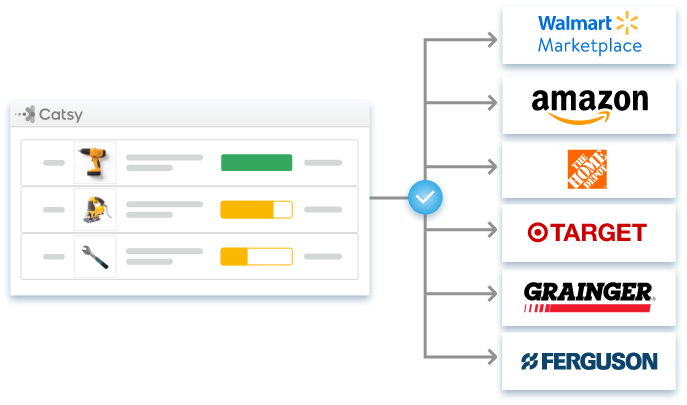
The Basics of PIM Software
A PIM system is a platform with which businesses manage the details of their products. The system is built on PIM software, allowing users to store product information. It also allows them to enrich the details during the product’s life cycle.
Like ERP, PIM systems centralize data related to a business’s products, streamlining the update and management processes. Users can also update and manage product details throughout multiple channels. In other words, a PIM system is a master-data-fueled, process-driven application with which organizations can manage their product information effectively across different teams and departments. Its ultimate objective is to increase customer engagement and grow product sales.

How a PIM system works
Recall TechWorks Inc. from the previous example of how an ERP system works. Let’s say the company pivots to electronics manufacturing – it now produces a wide range of consumer electronics products, such as laptops, smartphones, and smartwatches. It decides to implement a PIM system to manage product information and digital assets effectively.
First, TechWorks Inc. must gather all relevant product information and digital assets from different sources, such as suppliers, manufacturers, and internal teams. This information could include product specifications, descriptions, images, videos, and other media.
With the information ready, the company must standardize and centralize it in the PIM system. The PIM system would be a single source of truth for all product information and assets, allowing different teams to collaborate and access the same data.
The system would also allow TechWorks Inc. to enrich its product information by adding additional details and attributes to each product. For example, the company could add product dimensions, weight, and warranty information to a laptop product. It could also add different color options, accessories, and technical specifications to a smartphone product.
Once the data is enriched and standardized, it could then be distributed to different sales and marketing channels, such as e-commerce platforms, marketplaces, and social media channels. The PIM system would ensure that the data is accurate and up-to-date across all channels, reducing the risk of errors and inconsistencies.
Think of it this way, TechWorks Inc.’s PIM system is a central hub for all product information and digital assets. This allows the company to effectively manage and enrich product data, collaborate across teams, and distribute it accurately across different sales and marketing channels.
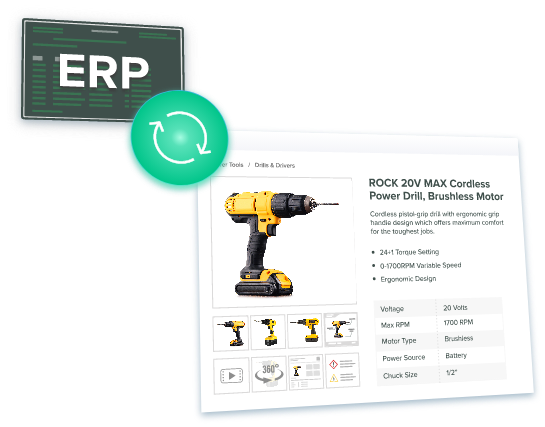
Integrating ERP and PIM Software
Integration means combining one thing with another to realize better results. As such, PIM ERP integration refers to combining the two solutions to achieve the best of what each platform offers. By merging their functionalities, businesses exploit their complementary benefits to realize more efficient and streamlined operations.
How to implement a PIM ERP integration
Before we learn how integrating ERP and PIM software can propel your e-commerce strategy, let’s see how you can implement the integration.
Suppose an online clothing retailer, ABC Apparel, uses Catsy PIM to manage product information, such as descriptions, images, and pricing. They also use the Oracle NetSuite ERP system to manage inventory, orders, and finances. They decide to integrate these two systems to streamline their operations and avoid manual data entry.
As the company begins the integration process, they realize it must go through several steps. Specifically, the process involves setting up a data exchange for Catsy and NetSuite so that the product information managed in Catsy is automatically synchronized with NetSuite.
Here’s how it works:
Step 1: Mapping data
The company must start by mapping the data fields in Catsy to the corresponding fields in NetSuite so that the data can flow smoothly between the two systems. For example, the SKU field in Catsy maps to the Item Number field in NetSuite. And the price field in Catsy maps to the Sales Price field in NetSuite.
Step 2: Syncing data
Once the data fields are mapped, the integration tool can start syncing the data between Catsy and NetSuite. For example, when a new product is added to Catsy, the integration tool can automatically create a new item record in NetSuite with the relevant product information.
Step 3: Updating data
The integration tool also ensures that any changes made to the product information in Catsy are reflected in NetSuite in real-time. For example, if the price of a product is updated in Catsy, the integration tool can automatically update the ‘Sales Price’ field in NetSuite.
Step 4: Consolidating data
In addition to syncing data, the integration tool can consolidate data from both systems to provide a complete view of the business operations. For example, the tool can pull data from NetSuite, such as sales orders and inventory levels, and combine it with data from Catsy, such as product descriptions and images, to provide a comprehensive view of the business operations.
With the integration between Catsy PIM and Oracle NetSuite ERP, ABC Apparel can now manage its product information in Catsy and have it automatically flow to NetSuite, eliminating the need for manual data entry and reducing errors. The company can also make informed decisions about inventory, orders, and financials by having a complete view of its operations.
This example is a barebones illustration of implementing a PIM-ERP integration. Nevertheless, it is already clear what benefits businesses obtain from the integration. For instance, ABC Apparel, the hypothetical company, doesn’t have to manage product data manually, preventing errors that could generate tremendous losses.
Let’s dig deeper into why integrating PMI and ERP will drive your e-commerce strategy.
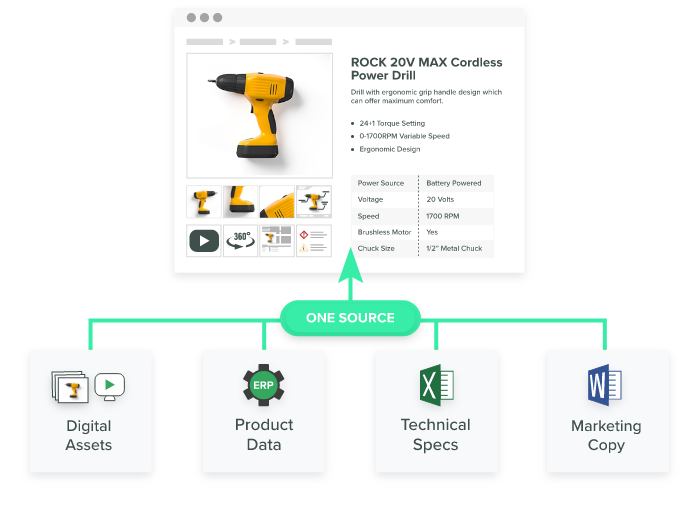
To centralize product data management
The primary objective for PIM ERP integration is to eliminate data silos that often generate errors when moving back and forth from one silo to another. Unfortunately, data silos are a common practice in organizations that have not embraced technology to the fullest.
A typical organization has several departments, each generating data for different purposes. Unfortunately, this decentralized nature of operations creates data silos. For example, let’s consider the online clothing retailer we’ve met before, ABC Apparel. It has four primary departments: marketing, sales, inventory management, and customer service.
Before PIM ERP integration, the marketing department used an ERP system to create and manage customer data. Also, the sales department used ERP software to collect and manage data on customer orders, revenue, and sales trends. On the other hand, the inventory management department used PIM software to manage data on inventory levels, order fulfillment rates, and stock counts.
All of the data is crucial to the organization’s overall performance, but it is often stored in separate databases, spreadsheets, or even paper files. This leads to data silos, where each department has its own set of data that is not easily accessible or shared with other departments.
The most significant benefit of PIM ERP integration is that it centralizes all of the business’s product data, especially all the critical parts. The business’s trajectory improves significantly when ERP information is brought together and centralized. In other words, the integration creates a single, easy-to-use hub for distribution to official product pages, making it easy to market the product.

To automate tasks and workflows
Sharing product information manually is prone to errors. Say, for example, that you want to send product information to distributors and retailers. To do this, you must gather and cleanse the information before sending it, which consumes lots of time.
Furthermore, you may want to share rich product information, and part of it may be stored in an ERP module. It would be cumbersome to share the data separately, exposing the process to errors.
Combining PIM and ERP systems removes this problem. In addition, it streamlines product data management by ensuring accurate and consistent data across all business systems, including marketplaces and e-commerce platforms.
Additionally, an automated product data management system is easily scalable. As the business grows, it will not require more hands for manual work. Overall, PIM and ERP integration increases operational efficiency and enhances scalability.
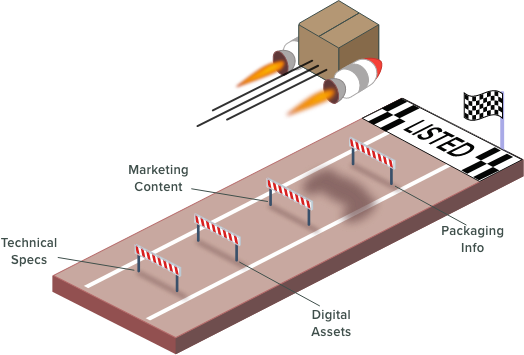
To achieve a faster time to market
In today’s competitive e-commerce space, thriving businesses move the fastest from idea to product shipping to retailers. Time to market describes the period between the idea and the actual product on the vendors’ shelves.
The production process is challenging and often relies on technologies like PIM tools for efficient operations. However, it is not uncommon to find that the business uses a separate ERP service to handle the customer-facing side of operations, creating two distinct dynamic parts.
While the two parts seemingly serve different purposes, they are closely interconnected. It means the business must share data from each system whenever required for particular decisions. Unfortunately, the data exchange must be done manually, introducing loopholes for errors and inaccuracies.
Instead, a PIM ERP integration breaks down the walls that created the data silos. For instance, the ERP side of the product launch system can provide crucial customer feedback that then expedites the idea implementation process (on the PIM side). The less time an organization spends between the idea implementation and shipping to vendors (customers), the more competitive it becomes.
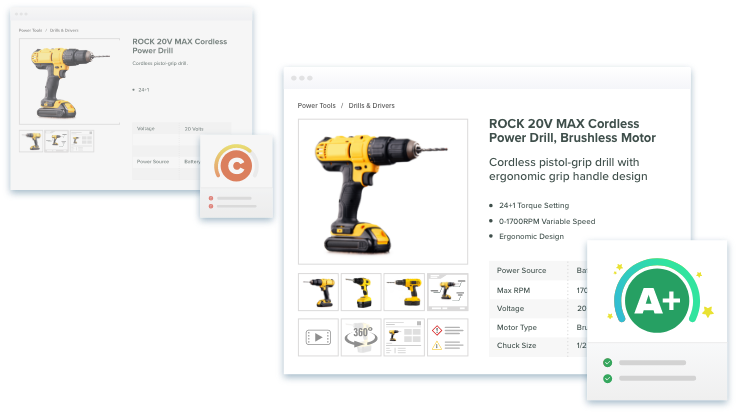
To improve the quality of product data
Most marketers know that sometimes products do not sell not because they are inferior but because of poor engagement.
Customer engagement involves cultivating genuine relationships between brands and customers. Trust undergirds this relationship, meaning it cannot exist if trust is not established first. In other words, trust is the currency that improves engagement, leading to higher sales.
Therefore, it is in the business’s interest to ensure that its operations inspire trust. The best way to do it is to provide accurate, complete, and up-to-date product information. Companies use PIM tools to achieve this goal.
But you also need to enrich the product data to increase its quality. For example, you may want to leverage sales data and analytics to re-engineer the product to serve the customer better. A centralized data hub provides immediate and streamlined access to the critical information you may need to improve product data quality.
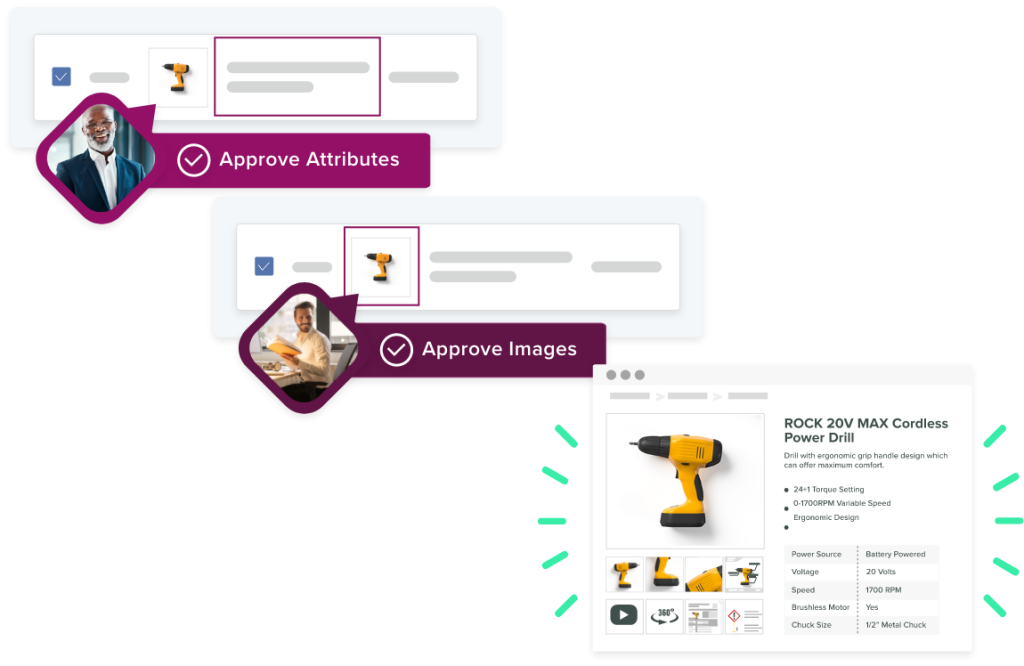
To improve product status updates
PIM ERP integration is essential in enabling and facilitating communication about product status. On the one hand, the ERP system oversees all updates related to stock availability, inventory, and monitoring activation. This way, you will be promptly notified to restock (the ERP system can restock if automation is enabled) whenever a specific product runs low in stock.
The ERP system must also communicate the SKU status to the PIM system. For example, the SKU status in the PIM should be deactivated when the product is running low on stock. An integrated ERP-PIM system communicates the information in real time, ensuring that all departments are up to speed. This eliminates the inefficiencies that would otherwise be commonplace due to slow SKU status communication.
ABOUT CATSY
Catsy has been providing unique value to the product information industry since 2003, allowing businesses a way to achieve high-quality product content. Our product information management (PIM) software centralizes all product data, so you can manage and share data with internal teams, retailers, and multiple platforms. Revolutionize your business with Catsy’s accuracy, automation, and optimization. To learn more, visit us at https://catsy.com.

